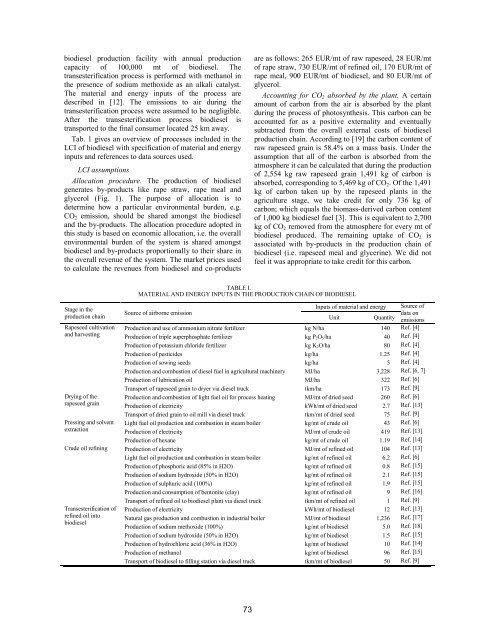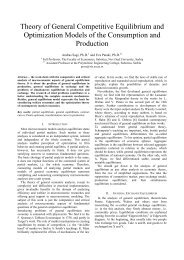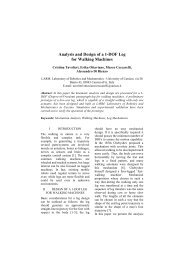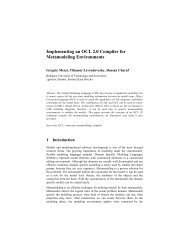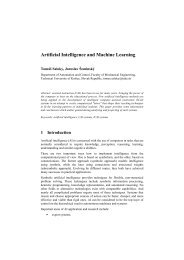A. LCI of biodieselThe process chain for biodiesel production consists ofrapeseed cultivation, grain drying, pressing and solventextraction of rapeseed oil, refining the crude rapeseed oil,transesterification of rapeseed oil into biodiesel, andfinally, distribution of biodiesel to final consumers. Themain product flow normalized in terms of the productionof one metric tone (mt) of biodiesel is presented in Fig. 1.Each stage of the process chain is discussed in more detailin following section.Process description and input dataRapeseed production. The method of cultivation andharvesting of oilseed rape modeled in this study as far aspossible reflects the usual practice in Vojvodina. It wasassumed that the annual yield was 2,305 kg rapeseed perhectare based on average yields of rapeseed in Vojvodinain a five year period (2005-2009). A sowing rate of 5 kgper hectare is assumed. Nitrogenous fertilizer is applied ata rate of 140 kg N/ha, corresponding to 400 kg/haammonium nitrate (35% N). Furthermore, the crop wasfertilized with 40 kg P 2 O 5 /ha and 80 kg K 2 O/ha,corresponding to 83 kg triple superphosphate fertilizerand 133 kg potassium chloride fertilizer, respectively. Asa result of chemical and microbiological processes in thesoil during cultivation, it was assumed that the airemissions of NH 3, N 2 O and NO were 74 g, 35 g, and 16 gper kg nitrogen supplied, respectively [3]. Regardingpesticides, 1 kg/ha of the herbicides Fusilade forte andBOSS 300 SL were used to control weeds and 0.25 kg/haof Megatrin 2.5 EC was used as insecticide. Theemissions from the process chain of fertilizers andpesticides were calculated after [4].For the cultivation operations, the total fuelconsumption was estimated at 90 l diesel fuel (3,228 MJ)per hectare based on [5]. The air emissions associatedFigure 1. Main material flows related to the production of 1,000kg biodiesel in Serbiawith the manufacturing of diesel fuel were calculatedwith data presented by [6] while the airborne emissionsfrom the combustion process were taken from [7]. Thevolume of lubrication oil consumed was assumed to be0.1 l/l of the diesel fuel used based on [8]. Furthermore, itwas assumed that manufacturing of lubrication oil resultsin the same amount of emissions as manufacturing ofdiesel oil.After harvesting raw rapeseed grain is transported viadiesel truck to the dryer which is located 37.5 km away.Data on air emissions associated with the combustion ofdiesel fuel in a truck were taken from [9].Seed drying. In Vojvodina oilseed is harvested with atypical moisture content of 13.5%, which must be reducedto at least 9% as a requirement for the oil extractionfacilities, and to ensure stability in storage [10]. It isassumed that the drying process takes place at a verticalgravity dryer Strahl 5000 FR (Officine Minute, Italy)powered by fuel oil and three electric fans of overallinstalled capacity of 54 kW. According to [10] the heatrequirement of the process is 260 MJ/mt of dried grainand electricity is consumed at a rate of 2.7 kWh/mt ofdried grain. The data source regarding airborne emissionsassociated with electricity and heat generation arespecified in Table 1. The dried grain is transported viadiesel truck to the oil mill plant which is located 37.5 kmaway.Solvent extraction and oil refining. After the dryingprocess, typical oilseeds contain 40-44% oil and 54-58%high protein meal [11]. The oil is extracted from the driedrapeseed by solvent extraction which is the mostdominant technology in the rapeseed oil industry. Thematerial and energy requirement of the process is basedon data presented by [11]. The process involves seedcleaning, cooking and flaking, before the seed is in anappropriate state for mechanical pressing to remove aproportion of the oil. After mechanical pressing, the rapemeal still contains a significant amount of oil; countercurrentsolvent extraction of the meal with hexane is usedto reduce this oil content to ca. 2%. The only materialused in the solvent extraction is hexane at a rate of 1.19kg per mt of crude rapeseed oil. The heating requirementof the plant is provided by steam produced from light fuelburned in industrial boiler, using 43 kg (1,797 MJ) lightfuel oil/mt crude rapeseed oil produced. Electricity isrequired at 419 MJ/mt of crude oil produced.In the refining step the phospholipids from the cruderapeseed oil are removed by the addition of phosphoricacid (H 3 PO 4 ). The remaining free fatty acids areconverted to soap by the addition of sodium hydroxide,and removed using a centrifuge. Other impurities areremoved via filtration using acid treated natural clay.Data on material and energy requirement of the refiningprocess is available from [11]. Light fuel oil is required at6.1 kg/mt crude oil to provide the refining plants’ heatingand electricity is required at 104 MJ/mt of refined oil.The refined oil is transported with diesel truck to thenearby transesterification plant located 1 km away.Transesterification. The transesterification of refinedrapeseed oil into biodiesel takes place at a state of art72
iodiesel production facility with annual productioncapacity of 100,000 mt of biodiesel. Thetransesterification process is performed with methanol inthe presence of sodium methoxide as an alkali catalyst.The material and energy inputs of the process aredescribed in [12]. The emissions to air during thetransesterification process were assumed to be negligible.After the transesterification process biodiesel istransported to the final consumer located 25 km away.Tab. 1 gives an overview of processes included in theLCI of biodiesel with specification of material and energyinputs and references to data sources used.LCI assumptionsAllocation procedure. The production of biodieselgenerates by-products like rape straw, rape meal andglycerol (Fig. 1). The purpose of allocation is todetermine how a particular environmental burden, e.g.CO 2 emission, should be shared amongst the biodieseland the by-products. The allocation procedure adopted inthis study is based on economic allocation, i.e. the overallenvironmental burden of the system is shared amongstbiodiesel and by-products proportionally to their share inthe overall revenue of the system. The market prices usedto calculate the revenues from biodiesel and co-productsare as follows: 265 EUR/mt of raw rapeseed, 28 EUR/mtof rape straw, 730 EUR/mt of refined oil, 170 EUR/mt ofrape meal, 900 EUR/mt of biodiesel, and 80 EUR/mt ofglycerol.Accounting for CO 2 absorbed by the plant. A certainamount of carbon from the air is absorbed by the plantduring the process of photosynthesis. This carbon can beaccounted for as a positive externality and eventuallysubtracted from the overall external costs of biodieselproduction chain. According to [19] the carbon content ofraw rapeseed grain is 58.4% on a mass basis. Under theassumption that all of the carbon is absorbed from theatmosphere it can be calculated that during the productionof 2,554 kg raw rapeseed grain 1,491 kg of carbon isabsorbed, corresponding to 5,469 kg of CO 2 . Of the 1,491kg of carbon taken up by the rapeseed plants in theagriculture stage, we take credit for only 736 kg ofcarbon; which equals the biomass-derived carbon contentof 1,000 kg biodiesel fuel [3]. This is equivalent to 2,700kg of CO 2 removed from the atmosphere for every mt ofbiodiesel produced. The remaining uptake of CO 2 isassociated with by-products in the production chain ofbiodiesel (i.e. rapeseed meal and glycerine). We did notfeel it was appropriate to take credit for this carbon.Stage in theproduction chainRapeseed cultivationand harvestingDrying of therapeseed grainPressing and solventextractionTABLE I.MATERIAL AND ENERGY INPUTS IN THE PRODUCTION CHAIN OF BIODIESELInputs of material and energy Source ofSource of airborne emissiondata onUnitQuantity emissionsProduction and use of ammonium nitrate fertilizer kg N/ha 140 Ref. [4]Production of triple superphosphate fertilizer kg P 2O 5/ha 40 Ref. [4]Production of potassium chloride fertilizer kg K 2O/ha 80 Ref. [4]Production of pesticides kg/ha 1.25 Ref. [4]Production of sowing seeds kg/ha 5 Ref. [4]Production and combustion of diesel fuel in agricultural machinery MJ/ha 3,228 Ref. [6, 7]Production of lubrication oil MJ/ha 322 Ref. [6]Transport of rapeseed grain to dryer via diesel truck tkm/ha 173 Ref. [9]Production and combustion of light fuel oil for process heating MJ/mt of dried seed 260 Ref. [6]Production of electricity kWh/mt of dried seed 2.7 Ref. [13]Transport of dried grain to oil mill via diesel truck tkm/mt of dried seed 75 Ref. [9]Light fuel oil production and combustion in steam boiler kg/mt of crude oil 43 Ref. [6]Production of electricity MJ/mt of crude oil 419 Ref. [13]Production of hexane kg/mt of crude oil 1.19 Ref. [14]Crude oil refining Production of electricity MJ/mt of refined oil 104 Ref. [13]Light fuel oil production and combustion in steam boiler kg/mt of refined oil 6.2 Ref. [6]Production of phosphoric acid (85% in H2O) kg/mt of refined oil 0.8 Ref. [15]Production of sodium hydroxide (50% in H2O) kg/mt of refined oil 2.1 Ref. [15]Production of sulphuric acid (100%) kg/mt of refined oil 1.9 Ref. [15]Production and consumption of bentonite (clay) kg/mt of refined oil 9 Ref. [16]Transport of refined oil to biodiesel plant via diesel truck tkm/mt of refined oil 1 Ref. [9]Transesterification ofrefined oil intobiodieselProduction of electricity kWh/mt of biodiesel 12 Ref. [13]Natural gas production and combustion in industrial boiler MJ/mt of biodiesel 1,236 Ref. [17]Production of sodium methoxide (100%) kg/mt of biodiesel 5.0 Ref. [18]Production of sodium hydroxide (50% in H2O) kg/mt of biodiesel 1.5 Ref. [15]Production of hydrochloric acid (36% in H2O) kg/mt of biodiesel 10 Ref. [14]Production of methanol kg/mt of biodiesel 96 Ref. [15]Transport of biodiesel to filling station via diesel truck tkm/mt of biodiesel 50 Ref. [9]73
- Page 1 and 2:
4 4 th IEEE International Symposium
- Page 3 and 4:
EXPRES 20124 th International Sympo
- Page 5 and 6:
Application of Thermopile Technolog
- Page 7 and 8:
Design of a Solar Hybrid System....
- Page 9 and 10:
___________________________________
- Page 11 and 12:
environmental protection and global
- Page 13 and 14:
But can we use the human body sweat
- Page 15 and 16:
IX. REFERENCES[1] Todorovic B. Cvje
- Page 17 and 18:
QQ⎛ Λt⎞=⎜⎟⎝ Λ ⎠Nt Nwh
- Page 19 and 20:
Analysis of the Energy-Optimum of H
- Page 21 and 22:
V. OBJECTIVE FUNCTIONThe objective
- Page 23 and 24: The Set-Up Geometry of Sun Collecto
- Page 25 and 26: continuous east-west sun collector
- Page 27 and 28: continuously measure the thermal ch
- Page 29 and 30: CEvaluation of measurement resultsA
- Page 31 and 32: Application of Thermopile Technolog
- Page 33 and 34: Temperature of the components [C]90
- Page 35 and 36: nighttime, to weather or to the cha
- Page 37 and 38: η uη u0.50.40.30.20.1T 1 - 400K0.
- Page 39 and 40: Figure 10. . SPS Concept illustrati
- Page 41 and 42: [16] Zoya B. Popović: Wireless Pow
- Page 43 and 44: 25.0020.0015.0010.005.000.00Figure
- Page 45 and 46: · ℃ 0.0738 · 1.209 0.0892
- Page 47 and 48: use may be advantageous not only in
- Page 49 and 50: To find the reasons for this disagr
- Page 51 and 52: Toward Future: Positive Net-Energy
- Page 53 and 54: EnergyPlus environment, we used mod
- Page 55 and 56: To keep future energy consumption d
- Page 57 and 58: A New Calculation Method to Analyse
- Page 59 and 60: On Fig. 3. can be seen the areas th
- Page 61 and 62: Present and Future of Geothermal En
- Page 63 and 64: TABLE II.THE TEMPERATURE DATA AND C
- Page 65 and 66: Error in Water Meter Measuring at W
- Page 67 and 68: III.RESULTS OF MEASURMENTSEach meas
- Page 69 and 70: TABLE I.THE AVERAGE VALUE OF THERMA
- Page 71 and 72: If the walls of the DHEs are made o
- Page 73: Environmental External Costs Associ
- Page 77 and 78: Contribution of unit processesto ex
- Page 79 and 80: Heat Pump News in HungaryBéla Ád
- Page 81 and 82: Thermal Comfort Measurements In Lar
- Page 83 and 84: IV.DISCUSSIONThe sample frequencies
- Page 85 and 86: For a Clear View of Traditional and
- Page 87 and 88: esults in geographically distribute
- Page 89 and 90: Design of a Solar Hybrid SystemMari
- Page 91 and 92: Maintaining the set point temperatu
- Page 93 and 94: Decision system theory model of ope
- Page 95 and 96: parameter of pump in the function o
- Page 97 and 98: Importance and Value of Predictive
- Page 99 and 100: D. Overview of existing boiler oper
- Page 101 and 102: HEAVY FUEL OIL FIRED, STEAMNATURAL
- Page 103 and 104: MATHEMATICAL MODEL AND NUMERICAL SI
- Page 105 and 106: C. Energy balance equationMathemati
- Page 107 and 108: Discretization energy balance equat
- Page 109 and 110: T ulf=32 º C, A - m =0.00162 kg/s,
- Page 111 and 112: Comparison of Heat Pump and MicroCH
- Page 113 and 114: the microCHP development. The energ
- Page 115 and 116: control and stabilizer must be deve
- Page 117 and 118: In Figure 1, in relation to the ord
- Page 119 and 120: NPCC BHXOBYNI x1I x2I x3I x4LO YKYO
- Page 121 and 122: exchange, as in reality, economies
- Page 123 and 124: esponsibilities for consequences, o
- Page 125 and 126:
Coca-Cola Enterprise Inc had approx
- Page 127 and 128:
Flow Pattern Map for In Tube Evapor
- Page 129 and 130:
circumference with a liquid film. T
- Page 131 and 132:
Tube diameter: d 6 mm W Heat flux
- Page 133 and 134:
Realization of Concurrent Programmi
- Page 135 and 136:
applications the development, optim
- Page 137 and 138:
Renewable energy sources in automob
- Page 139 and 140:
commercial arrays can be built at b
- Page 141 and 142:
of multiple thin films produced usi
- Page 143:
EXPRES 20124 th International Sympo


